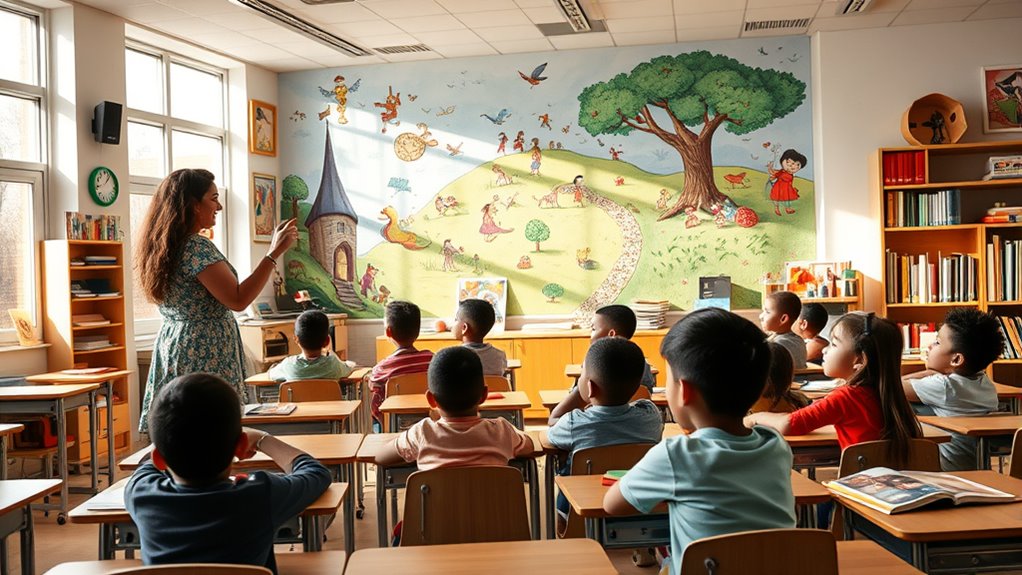Narrative transportation occurs when your audience becomes emotionally connected to a story, making lessons more engaging and memorable. By using well-structured stories with relatable characters and vivid details, you help learners turn abstract ideas into real experiences, deepening their understanding and retention. Incorporating storytelling techniques and multimedia boosts emotional impact. If you want to discover how to craft powerful educational stories that truly resonate, keep exploring the strategies that can transform your teaching.
Key Takeaways
- Narrative transportation creates emotional engagement, making lessons more memorable and facilitating deeper understanding.
- Well-structured stories guide attention and foster emotional connections through clear beginning, middle, and end.
- Incorporating vivid, relatable characters and details enhances emotional resonance and retention.
- Multimedia storytelling combines visuals and sound to immerse learners and reinforce concepts effectively.
- Tailoring stories to cultural and personal contexts increases relevance, empathy, and long-term learning impact.
Understanding Narrative Transportation and Its Role in Education
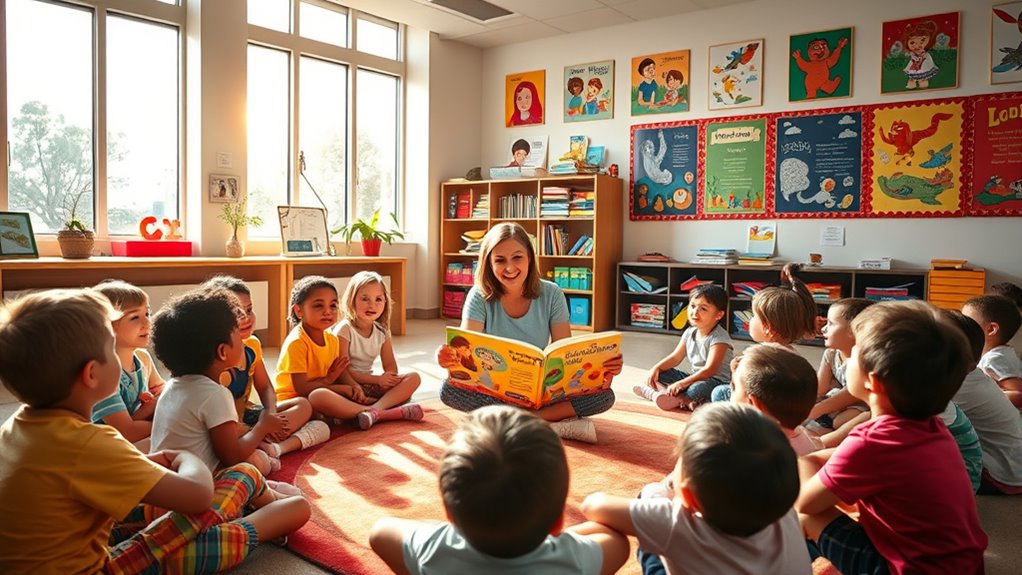
Understanding narrative transportation is essential because it explains how stories can engage you deeply, making learning more effective. When you follow a well-crafted story structure and narrative arc, you’re more likely to become immersed in the material. A strong narrative arc guides you through a beginning, middle, and end, creating emotional connections and increasing focus. This journey keeps you invested, helping you remember information better. In education, utilizing stories with clear story structures turns abstract concepts into relatable experiences. As you follow the narrative arc, your attention stays fixed, and you’re more receptive to learning. Recognizing how this process works allows educators to design lessons that harness your natural response to compelling stories, fostering deeper understanding and retention. Additionally, incorporating storytelling techniques rooted in scientific principles can further enhance engagement and memory retention.
The Psychological Impact of Storytelling on Learners
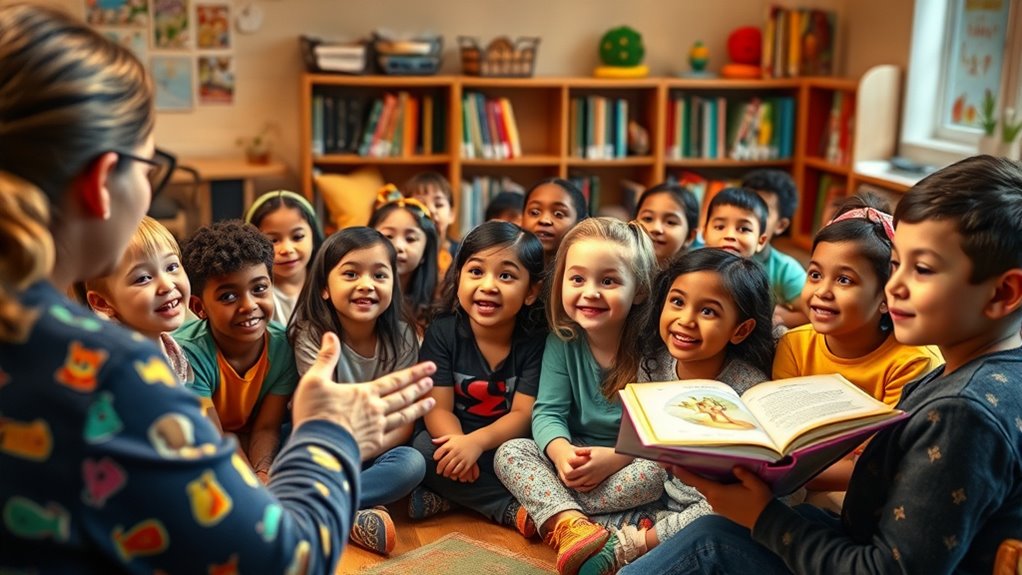
When you use storytelling, you can increase emotional engagement, making information stick better. This connection helps learners remember content more effectively. Additionally, stories foster empathy, leading to a deeper understanding of different perspectives. Incorporating appliance maintenance plans into educational narratives can also demonstrate the importance of preventive care and long-term planning.
Emotional Engagement Boosts Retention
Engaging learners emotionally through storytelling substantially enhances their ability to remember information. When you connect with stories on an emotional level, you activate emotional memory, making the material more memorable. Emotional engagement triggers feelings that embed lessons deeper into your mind, increasing the likelihood of long-term retention. Effective engagement strategies include using vivid narratives, relatable characters, and evocative language that evoke genuine emotions. These techniques help learners experience the story, not just hear it, fostering a stronger psychological connection. As a result, learners are more motivated to pay attention and internalize concepts. By tapping into emotions, storytelling transforms passive listening into active involvement, solidifying understanding and recall. This emotional resonance is a powerful tool for boosting learning outcomes. Incorporating storytelling techniques that leverage emotional engagement can further amplify these benefits, making lessons more impactful.
Empathy Fosters Deeper Understanding
Empathy acts as a bridge that connects learners emotionally to the story, fostering a deeper understanding of the material. When you put yourself in a character’s shoes, you naturally explore ethical dilemmas from multiple angles, gaining insight into complex issues. Storytelling that highlights cultural perspectives helps you appreciate diverse worldviews, strengthening your empathy. This emotional connection encourages you to contemplate different moral choices and societal norms, making lessons more impactful. As you navigate these narratives, you’re not just passively absorbing information—you’re actively engaging with the material on a personal level. This process deepens comprehension and helps you retain knowledge more effectively. Additionally, integrating emotional expression into storytelling can further enhance emotional engagement and understanding. Ultimately, empathy in storytelling transforms learning into a meaningful exploration of human experiences, promoting critical thinking and cultural awareness.
Techniques for Incorporating Stories Into Teaching Strategies
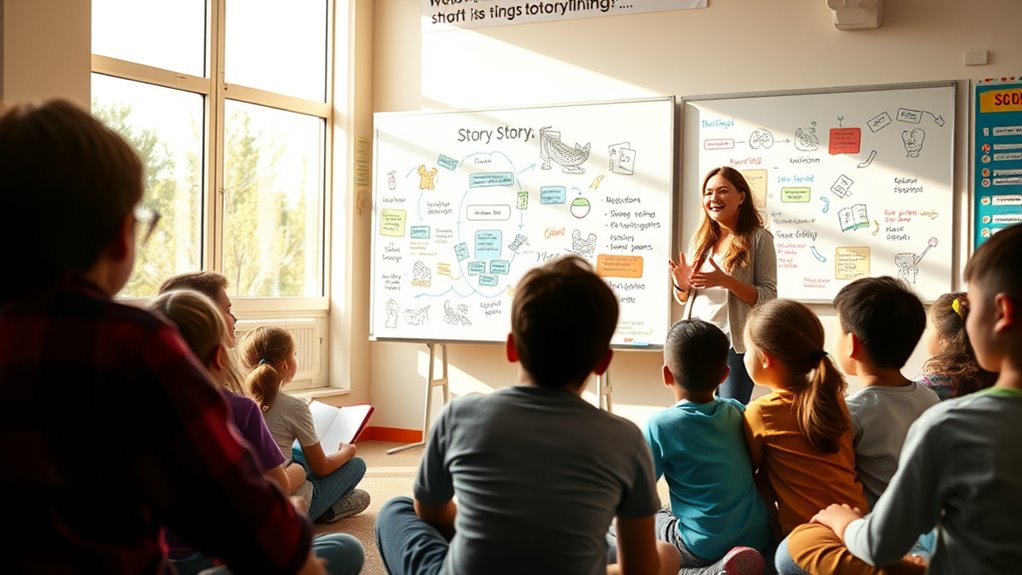
Incorporating stories into teaching strategies can substantially boost student engagement and understanding. To do this effectively, you should be aware of storytelling myths that can hinder genuine connection, such as the idea that stories must be complex or overly dramatic. Instead, focus on clear narrative structures—beginning, middle, and end—that guide learners naturally through the material. Use concise, relatable stories that align with your lesson’s objectives, ensuring they serve as meaningful examples rather than distractions. Incorporate personal anecdotes or historical narratives to make concepts more tangible. Simplifying storytelling myths and emphasizing strong narrative structure helps you craft stories that captivate students and reinforce key ideas, making lessons more memorable and impactful. Recognizing dream symbols can also help tailor stories to resonate deeper with learners’ subconscious associations, enriching the learning experience.
Benefits of Using Narratives to Improve Retention and Comprehension
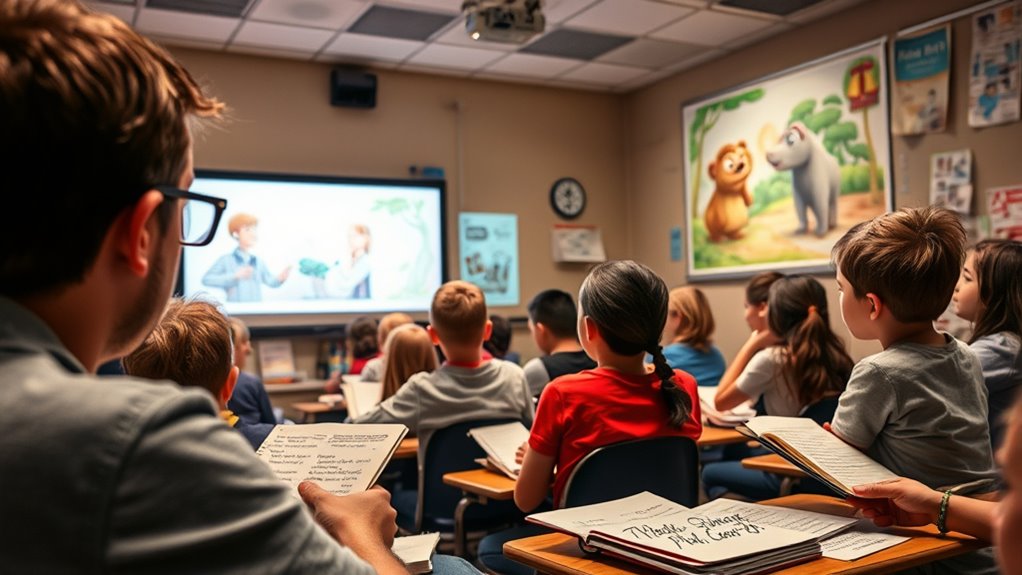
Using narratives in teaching substantially enhances both retention and comprehension by making information more memorable and meaningful. Cultural narratives embed lessons within familiar stories, fostering connection and relevance that deepen understanding. When you analyze these stories through narrative analysis, you uncover underlying themes and structures that clarify complex concepts. This process helps you see relationships and patterns, making material easier to recall. Stories engage emotions and personal experiences, which boost memory pathways. Additionally, incorporating cultural narratives respects diverse perspectives, increasing engagement and making learning more inclusive. Overall, using stories not only improves your ability to remember information but also enriches your grasp of the material, creating a more impactful and lasting learning experience. Incorporating raw food diets into stories can also illustrate health benefits and practical considerations, making the concepts more relatable and easier to remember.
Examples of Effective Storytelling in Various Educational Settings
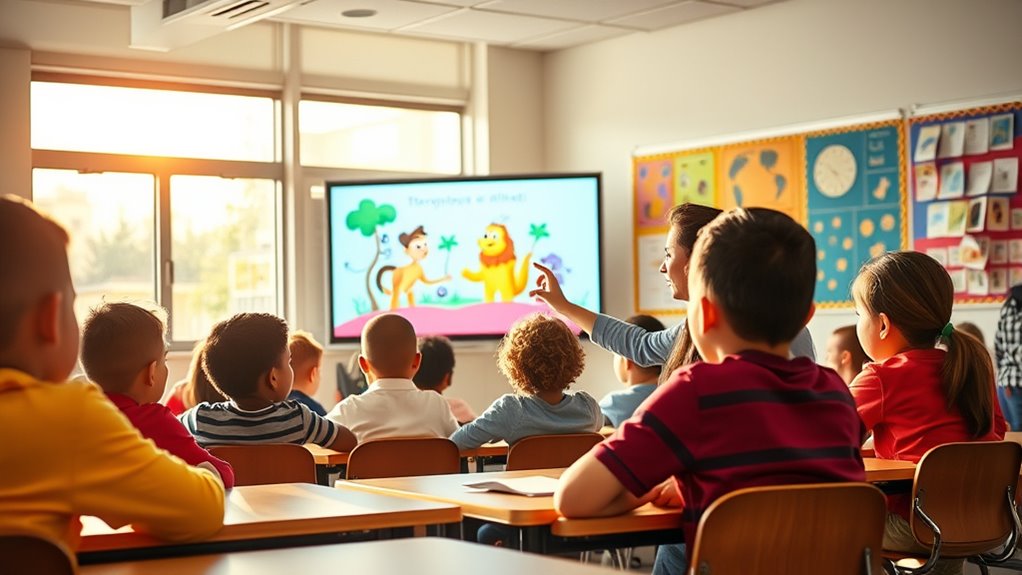
You can see how classroom storytelling techniques engage students and make lessons more memorable. Digital storytelling examples also show how technology enhances narrative learning. Exploring these methods reveals effective ways to captivate learners across different educational settings. Incorporating traditional butter-making techniques into lessons can provide cultural and historical context, enriching students’ understanding of food heritage.
Classroom Storytelling Techniques
Effective storytelling in the classroom captures students’ attention and makes lessons memorable, regardless of the subject. To do this, you should prioritize storytelling ethics, ensuring your stories are respectful, accurate, and inclusive. Emphasize narrative diversity by sharing stories from different cultures, perspectives, and experiences, which helps students connect with varied viewpoints. Use vivid language and expressive gestures to bring stories to life and foster engagement. Incorporate questioning techniques to encourage critical thinking and active participation. Keep stories relevant to your lesson goals, making sure they reinforce key concepts. Remember, ethical storytelling builds trust and respects your students’ backgrounds, while embracing narrative diversity enriches the learning environment and broadens horizons. These techniques create meaningful, memorable classroom experiences that resonate beyond the lesson. Including elements like Floating on Water can also provide calming or energizing breaks, supporting student focus and well-being.
Digital Storytelling Examples
Digital storytelling brings classroom narratives to life through multimedia elements like images, audio, and video, making lessons more engaging and memorable. You can use interactive media to create immersive experiences that capture students’ attention and foster deeper understanding. For example, history teachers might craft visual storytelling projects where students develop digital timelines with images, narration, and sound effects, helping them grasp complex events. Science educators can incorporate videos and animations to illustrate processes, encouraging active participation. These examples show how digital storytelling enhances learning by combining multimedia tools with storytelling techniques. Incorporating high-quality projectors can significantly improve the clarity and impact of visual presentations, making stories more vivid and engaging. These approaches make lessons more dynamic, encourage creativity, and help students connect emotionally with the content, ultimately boosting retention and comprehension.
Tips for Crafting Engaging and Memorable Educational Stories
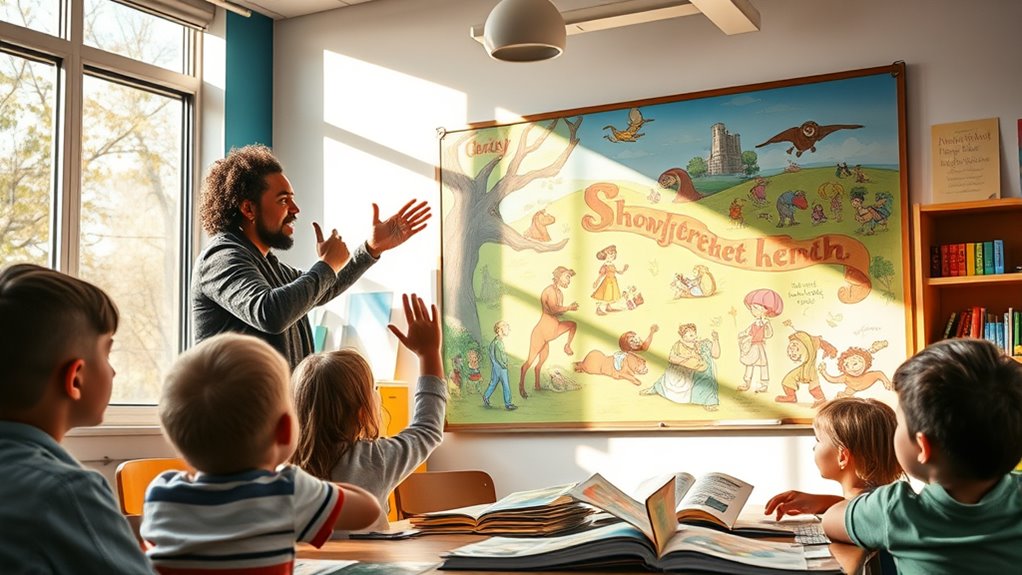
Crafting engaging and memorable educational stories begins with understanding your audience and tailoring your message to resonate with their interests and experiences. To do this effectively, avoid common storytelling pitfalls like overcomplicating your narrative or losing focus. Keep your story clear and relevant, emphasizing narrative authenticity to build trust and engagement. Use relatable characters and situations that connect with learners’ real lives. Incorporate vivid details and emotional elements to make your story memorable. Be genuine and honest; authenticity fosters a deeper connection. Don’t rush the storytelling process—take time to craft a compelling plot and meaningful message. When you focus on these tips, your stories will not only capture attention but also leave a lasting impact. Additionally, consider retail hours to ensure your storytelling sessions or workshops are scheduled at optimal times for your audience.
Frequently Asked Questions
How Can Teachers Measure the Effectiveness of Narrative Transportation?
You can measure the effectiveness of narrative transportation by analyzing assessment metrics and engagement indicators. Look for improvements in student understanding, retention, and participation during storytelling activities. Use quizzes, reflections, or discussions to gauge comprehension, and observe whether students stay attentive and involved. These indicators help you determine if your storytelling genuinely immerses students, making the learning experience more impactful and memorable.
What Are Common Pitfalls When Integrating Stories Into Lessons?
Imagine you’re using stories in your lessons but struggle with story selection and pacing techniques. Common pitfalls include choosing stories that don’t align with your learning goals or losing student engagement due to poor pacing. For example, a teacher might pick an overly complex story, making it hard to follow. To avoid this, select relevant stories and maintain steady pacing to keep students engaged and focused on key concepts.
How Does Cultural Background Influence Storytelling in Education?
You should consider how cultural nuances and storytelling traditions influence education. Your students’ cultural backgrounds shape how they interpret stories, impacting engagement and understanding. When you incorporate diverse storytelling traditions, you create a more inclusive classroom that respects different perspectives. Being aware of these cultural influences helps you select stories that resonate with students, making lessons more meaningful and effective in fostering learning and connection across varied cultural contexts.
Can Digital Storytelling Enhance Narrative Transportation?
Imagine you’re guiding students through a vivid digital landscape. Digital storytelling uses interactive visuals to boost student engagement, making lessons feel like immersive journeys. This approach can markedly enhance narrative transportation, as students become active participants in the story. Studies show that stories with engaging visuals keep learners more involved, helping them connect emotionally and cognitively. So, yes, digital storytelling effectively enhances narrative transportation by making learning experiences more dynamic and memorable.
What Age Groups Benefit Most From Storytelling-Based Learning?
You might wonder which age groups benefit most from storytelling-based learning. Generally, children, especially early learners, gain the most through age-specific strategies that align with their developmental benefits. Young kids develop language skills and emotional understanding, while adolescents enhance critical thinking and empathy. Tailoring stories to each age guarantees engagement and maximizes learning outcomes, making storytelling a powerful tool across various developmental stages.
Conclusion
While textbooks provide facts, stories ignite your imagination and deepen understanding. You might forget dates, but a compelling narrative leaves a lasting impression. By weaving stories into your teaching, you create a bridge between knowledge and emotion, transforming dry information into memorable experiences. Ultimately, storytelling doesn’t replace facts—it enhances them. Embrace stories to make learning both meaningful and engaging, turning education from mere information into an inspiring journey you and your students will never forget.
